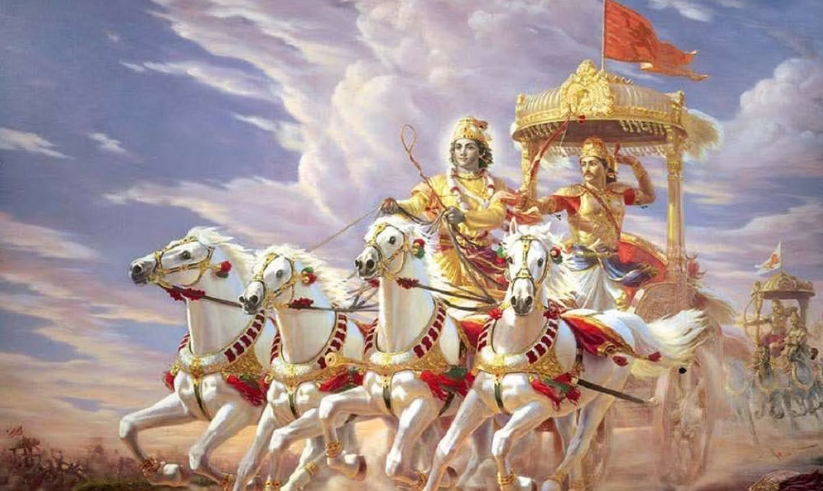Blog

The Bhagavad Gita
The Bhagavad Gita is a text very close to my heart. I have read it many times and I keep returning to it, because every time I go through its pages I realize anotherm profound truth of myself but also of the world around me. The Bhagavad Gita is a classical Hindu text and is one of the most important philosophical and spiritual works in the world, but is often misunderstood as a text about war, when in fact it is primarily a spiritual text about the nature of the self and the universe, and the path to spiritual growth and realization. While the context of the story is a war, in order to talk about the challenges of life we all eventually have to face, the teachings of the Gita go far beyond that and are applicable to all aspects of life.
The text revolves around a dialogue between Arjuna, a warrior prince, and his charioteer, Krishna, who is an incarnation of God. Arjuna is reluctant to fight in a war between two branches of his family, fearing that he will kill his relatives and incur sin. Krishna explains to him the nature of the self and the universe, and teaches him the path of selfless action, or karma yoga, which involves acting without attachment to the results of one’s actions.
Krishna teaches Arjuna that the true self is not the body or the mind, but an immortal, indestructible spirit that is identical with God. He explains that the purpose of life is to realize this true self, and that this can be achieved through various spiritual practices
such as meditation, devotion, and selfless service. Also, Krishna points out the importance of dharma: Dharma is often translated as “duty” or “righteousness”, and it is a central concept in the Gita. The Gita teaches us that we should fulfill our duties according to our station in life, and that this can help us achieve spiritual growth.
Krishna also discusses the three gunas, or qualities of nature: sattva, rajas, and tamas. Sattva is the quality of purity and knowledge, rajas is the quality of passion and activity, and tamas is the quality of inertia and ignorance. Krishna explains that these qualities
are present in all of us, but that we should strive to cultivate sattva and reduce rajas and tamas. Learnings and Insights of this classical text:
-
- The importance of self-knowledge: The Bhagavad Gita emphasizes the importance of knowing oneself, and recognizing that the true self is not the body or the mind, but an immortal, indestructible spirit that is identical with God. This
knowledge can help us overcome fear, attachment, and suffering.
- The importance of self-knowledge: The Bhagavad Gita emphasizes the importance of knowing oneself, and recognizing that the true self is not the body or the mind, but an immortal, indestructible spirit that is identical with God. This
-
- The path of selfless action: The Gita teaches us that we should act without attachment to the results of our actions. This means performing our duties with dedication and sincerity, but without being attached to the outcome. This can help us cultivate detachment, equanimity, and inner peace.
-
- The power of self-transformation: The Gita teaches us that we have the power to transform ourselves through our actions, thoughts, and attitudes. By cultivating virtues such as compassion, patience, and humility, we can transform ourselves
and achieve spiritual growth.
- The power of self-transformation: The Gita teaches us that we have the power to transform ourselves through our actions, thoughts, and attitudes. By cultivating virtues such as compassion, patience, and humility, we can transform ourselves
-
- The three gunas: The Gita teaches us that we all have a mixture of the three gunas, but that we should strive to cultivate sattva and reduce rajas and tamas. This can help us lead a more balanced and harmonious life.
-
- The importance of spiritual practices: The Gita teaches us that spiritual practices such as meditation, devotion, and selfless service can help us realize our true self and achieve inner peace. These practices can also help us cultivate virtues
such as compassion, patience, and humility.
- The importance of spiritual practices: The Gita teaches us that spiritual practices such as meditation, devotion, and selfless service can help us realize our true self and achieve inner peace. These practices can also help us cultivate virtues
-
- The role of a teacher: The Gita emphasizes the importance of having a spiritual teacher or guru who can guide us on our spiritual path. A good teacher can help us understand the scriptures, overcome our doubts and obstacles, and lead us to
the realization of our true self.
Overall, the Bhagavad Gita offers a wealth of teachings and values that can help us lead a more meaningful and fulfilling life, and that are applicable to people of all cultures and backgrounds. Its teachings on dharma, unity, detachment, devotion, and self-
transformation can help us overcome the challenges of life and achieve spiritual growth.
- The role of a teacher: The Gita emphasizes the importance of having a spiritual teacher or guru who can guide us on our spiritual path. A good teacher can help us understand the scriptures, overcome our doubts and obstacles, and lead us to
By Angeliki Lalagianni
